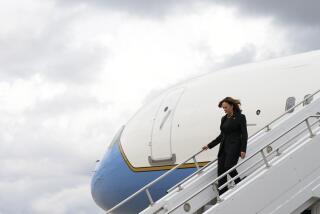Train fans happily on security watch
With a round face, curly mop of sandy hair and shy demeanor, bespectacled Wayne Davis looks like an average American, but he claims that, as a railroad buff, he is also a vital asset to national security.
“We are a valuable natural resource in the war on terror,” Davis, 33, says of himself and hundreds of thousands like him.
A machine worker from Beloit, Wis., Davis has come to Rochelle, a small town where the tracks of the two largest U.S. railroads -- Union Pacific Corp. and Burlington Northern Santa Fe Corp. -- cross, guaranteeing that around 100 trains will pass every 24 hours.
“I’ve loved trains since I was 2 years old,” he said, his boyish face lighting up.
Whenever a train comes into view, Davis springs to his feet and grabs his video camera to record the event so he can relive it later at home. Although it is a weekday in November, around 30 other people are here.
In Rochelle and at hundreds of other locations around the country -- from Pennsylvania’s Horseshoe Curve to Dolton Junction in Chicago -- rail fans gather to take notes or shoot photos of the passing trains. They watch the tracks via webcams and discuss their observations in Internet chat groups.
Often ridiculed for their obsession with everything to do with trains, they have earned the industry nickname “foamers” -- alluding to a passion verging on the rabid.
Some fans complain that, following the terrorist attacks of Sept. 11, 2001, they were harassed by the authorities for photographing or filming trains. Such scrutiny, in light of events, in fact can be viewed as suspicious for fear of fresh attacks on U.S. soil.
“Due to concerns over national security, we saw a number of rail fans apprehended while pursuing their hobby,” said James Andrisen, spokesman for the 19,000-member U.S. National Railroad Historical Society.
But as their activities have persisted, one railroad has sought to use train buffs as a volunteer force to help monitor its 32,000 miles of track and report any suspicious activity.
Burlington Northern’s club, Citizens for Rail Security, since its launch in July has attracted nearly 6,000 members and gained the approval of folks such as Davis.
“A lot of fans are pleased BNSF has realized what we can do on its behalf,” he said.
The other major railroads presently have no plans to follow suit, but analysts say this may be a good, low-cost way to boost surveillance along tens of thousands of miles of track.
A trip to Rochelle for many rail buffs is tantamount to making a pilgrimage. To accommodate visitors, the town has set up a year-round pavilion.
“On average, we get around 1,000 people a week here,” said Rick Barnes, a self-confessed foamer and owner of a train-focused gift shop located in a parking lot near the pavilion.
Among the visitors is Don Gosnell, 43, who has traveled nearly 500 miles from his home in Ashtabula, Ohio.
Here for nearly 30 hours -- Gosnell spent the night watching trains from his car in the parking lot -- he takes notes rapidly every time a train passes.
“Trains make me feel like a kid again,” Gosnell said, eyes gleaming. When asked how many trains he has seen, he quickly consults his notes and replies: “111 so far.”
Rail fans such as Gosnell are so devoted that when legislation on the industry is due for debate, they “write to their representatives in Congress supporting the railroads,” said Tom White, spokesman for lobby group the Assn. of American Railroads.
Trains Magazine, the largest publication for train aficionados, has 96,000 subscribers.
It is this passion that Burlington Northern has decided to harness using Citizens for Rail Security.
“We feel it’s time to take their devotion to the next level,” Burlington Northern spokesman Patrick Hiatte said.
Rail fans are encouraged to report suspicious activity by calling the railroad’s hotline. The club adheres to Burlington Northern rules: Fans are not allowed on railroad property and may not photograph trains hauling military equipment.
National Railroad Historical Society spokesman Andrisen said “in doing this BNSF has recognized a tremendous asset.”
He said rail fans are very familiar with how the railroads work and would instantly recognize suspicious behavior.
“We are best suited to notice and help out,” he added.
But so far, Burlington Northern is the only major U.S. railroad to offer rail fans official status.
Executives at Union Pacific, CSX Corp. and Norfolk Southern Corp. said they had no plans to follow suit, but point out that they have public hotlines available to report suspicious activity.
Stephen Brown, a transportation analyst at Fitch Ratings, said he could “not see any negative aspects” for railroads thinking of adopting a program such as Burlington Northern’s.
“If it’s cost-free and allows the railroads to use extra eyes and ears on tens of thousands of miles of track that are difficult and expensive to police,” he said, “then why not?”
More to Read
Sign up for Essential California
The most important California stories and recommendations in your inbox every morning.
You may occasionally receive promotional content from the Los Angeles Times.










